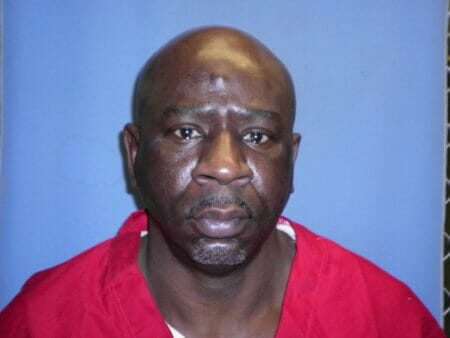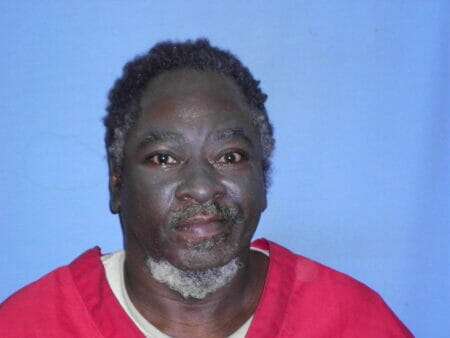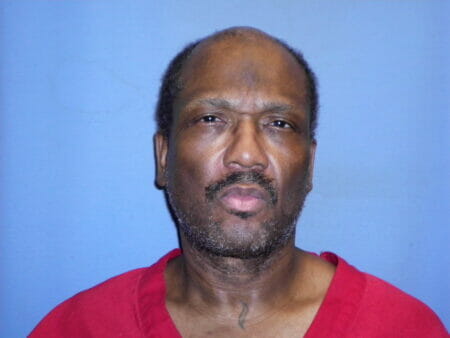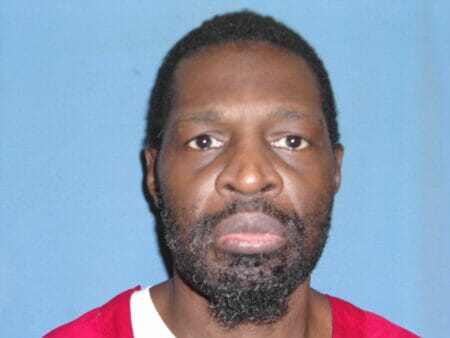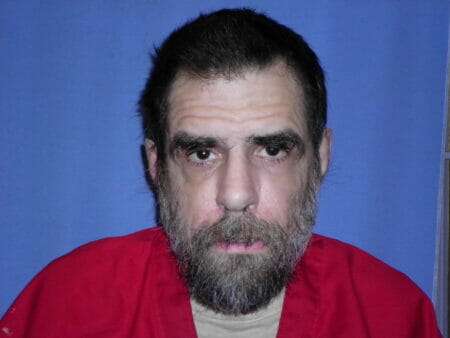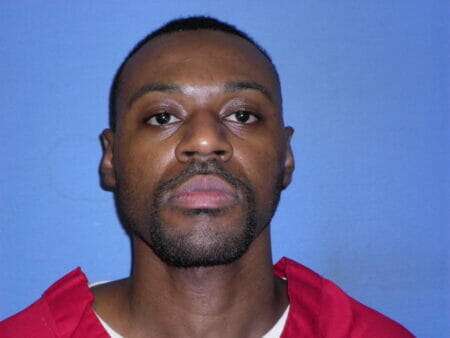
Caleb Carrothers was sentenced to death by the State of Mississippi for a double murder. According to court documents Caleb Carrothers chased one of the victims into his home and would shoot and kill Taylor and Frank Clark and shoot and injure another man. Caleb Carrothers was arrested, convicted and sentenced to death.
Mississippi Death Row Inmate List
Caleb Carrothers 2021 Information
| Race: BLACK | Sex: MALE | Date of Birth: 01/10/1982 |
| Height: 6′ 1” | Weight: 185 | Complexion: DARK |
| Build: MEDIUM | Eye Color: BROWN | Hair Color: BLACK |
| Entry Date: 05/20/2011 | Location: MSP | UNIT: UNIT 29 |
| Location Change Date: 02/03/2021 | Number of Sentences: 3 | Total Length: DEATH |
Caleb Carrothers More News
Taylor Clark, a twenty-year-old white male, was the youngest son of Frank and Tonya Clark. Known as an outgoing individual, Taylor was generally liked by everyone; however, trial evidence indicated that he was known throughout his community to sell marijuana “from time to time.” According to the evidence, he usually carried four to five hundred dollars on him.
¶ 3. On the night of July 11, 2009, Taylor dropped off his girlfriend at her house around 9:00 p.m. and told her he was going home. Rather than going directly home, he went to Karen Hickinbottom’s house at 2516 University Avenue. Hickinbottom was a friend of Taylor’s and the girlfriend of his marijuana dealer. Karen testified at trial that Taylor stopped by her house around 9:00 p.m. on July 11, to return a cell phone belonging to her boyfriend, which he had left in Taylor’s car earlier that day.
¶ 4. Karen had known Taylor for about a year, and she bought marijuana from him. Taylor was talking with Karen and her daughter when Karen’s son came home and said that someone outside wanted to talk to Taylor. Taylor went outside, then came back in and said it was someone who wanted to buy drugs. The man outside came to the door a few minutes later, demanding to talk to Taylor again. Karen testified that Taylor went outside again to talk to the man, then came back in and said “Man, I got to get out of here.” Karen saw the man get in the passenger seat of Taylor’s car, and they drove off. She said they left her house between 9:30 p.m. and 10:30 p.m. Karen would later describe the man who left with Taylor as a “6 foot to 6′2″ black male, medium build, very low cut hair.”
¶ 5. Sometime after 11:00 p.m. on the night of July 11, 2009, Taylor pulled up to his family’s home, jumped out of his car, and ran into the house. An armed man got out of the passenger side of Taylor’s car and chased Taylor toward the house. Taylor’s older brother, Josh, was standing outside smoking a cigarette. Josh had suffered significant physical injuries in two recent car accidents, and he was barely able to walk without assistance. Taylor’s parents, Frank and Tonya, were in the house asleep. Taylor ran into the house screaming to wake his parents, saying that a man was “fixing to kill Josh.”
¶ 6. Frank ran from his bedroom to aid Taylor and attempted to hold the door shut to prevent the man from entering the house. The man shot through the door, then reached his arm around the door, shooting and killing Frank. The man was then able to enter the house. He shot Tonya twice in the neck, and Taylor came running to attack the man. He shot Taylor twice, killing him. Tonya testified that the man then went to her bedroom, got a rifle from her husband’s collection, returned to the living room, and pointed the gun at her. When he realized that the rifle was not loaded, he wiped it off with a rug and threw the gun and the rug down.
¶ 7. The man then turned on Josh, who had entered the house and retreated to his bedroom. The man threatened Josh and demanded to know “where the money was.” Tonya was able to get to Josh’s room and force herself between Josh and the attacker. The man demanded money and car keys. Tonya gave him all the money she had in her purse—about $50—and the spare keys to Taylor’s car, a white Crown Victoria. The man left the house and approached a car in the driveway. Tonya followed him out of the house, asking why he had done this. The man claimed that Taylor owed him $5,000. He attempted to use the keys to get into the wrong car, and Tonya yelled at him that the keys went to the Crown Victoria. The man got into the car and drove off, going left out of the Clarks’ driveway, down a dead-end road. Tonya dialed 911 before he was out of the driveway. Tonya’s call was received at 11:38 p.m.
¶ 8. When police arrived, they found Taylor’s car abandoned down the road from the Clarks’ driveway. The car was left running and the driver-side door was open. Police searched the car, revealing a F.I.E. brand .38 caliber revolver with six spent shell casings in it. No fingerprints were found on the weapon, in the house, or in the car that would aid in identifying the attacker, nor was forensic or DNA evidence found that would link a suspect to the crime. Soon after the car was found, a police K–9 unit searched the wooded area surrounding the car to no avail.
¶ 9. Around 4:15 a.m. on July 12, 2009, approximately four and half hours after the attacker had left the Clarks’ house, Taylor Windham was walking in Grand Oaks neighborhood near Majestic Oaks Drive as he did nearly every morning at that time. A thickly wooded area covering approximately two miles separated Grand Oaks from the Clarks’ house. While on his morning walk, Windham noticed a shirtless man approaching him. According to Windham, the man said that he had been jumped and that he was lost. He asked where the neighborhood was and asked for directions to Highway 7. Windham pointed him in the direction of the highway. He described the man as approximately five feet, ten inches tall, slim but muscular, and wearing baggy pants but no shirt. Windham then hid in a neighbor’s driveway and watched the man walk toward the intersection of Highway 7 and Belk Boulevard.
¶ 10. At 4:53 a.m., a shirtless man, covered in scratches, entered a Kangaroo Express gas station on Belk Boulevard. Kevin Maxey was working at that time, and the man told Maxey that he had been jumped by six people. The man used the phone to make two phone calls, but he did not get an answer. The man asked to borrow a shirt, but Maxey did not give him one. He then bought cigarettes, a lighter, juice, and cinnamon rolls, and paid with cash. Maxey testified at trial that the man did not seem nervous or scared and did not act like someone who had just been jumped. At the time, Maxey thought the man was attempting to call the police. The gas-station security camera captured most of the exchange. The video clearly shows an African–American man wearing baggy pants and no shirt. Maxey also testified that the man had scratches all over him; however, the scratches do not clearly appear in the video.
¶ 11. Police identified the man in the gas-station surveillance video as Caleb Corrothers and compiled a six-person photo lineup that included Corrothers’s photo. They showed the lineup to Tonya and Josh at the funeral home during the visitation for Frank and Taylor, five days after the murders. Tonya and Josh were shown the lineup separately. Tonya could not identify the attacker from the photo lineup, but Josh identified Corrothers as the attacker. A search warrant was issued for Corrothers’s arrest. Corrothers turned himself in to police after learning of the warrant. Investigator Scott Mills testified that, when Corrothers came to the police station, he had scratches on his face, head, and body, band-aids on his head, and an injury to his left thigh. Investigator Mills’s testimony was corroborated with photographs taken of Corrothers when he arrived at the police station.
¶ 12. Caleb Corrothers gave a statement to police, which was recorded, but he denied any involvement in the murders. At the beginning of the recorded interrogation, Investigator Mills read Corrothers his Miranda1 rights. When asked if he knew Taylor, Corrothers said that he had bought marijuana from Taylor in May at a house near Tammy’s Salon. Tammy’s Salon is located down the road from Karen Hickinbottom’s house on University Avenue. Corrothers told Investigator Mills a colorful story about his whereabouts on the night of murders.
¶ 13. Caleb Corrothers said that on the night of July 11, he left his mother’s home in the Brittany Woods subdivision and went to the Field, which is a building off Highway 6 East that is rented out for parties. He went to the Field with a man from Memphis named Suave. While there, Suave approached Corrothers about smoking marijuana. The two drove out into the county to smoke, when, for reasons unknown, Suave attacked Corrothers. Suave pulled out a gun, but Corrothers grabbed the gun and disarmed him; at some point, the gun discharged and grazed Corrothers’s left thigh. Corrothers’s friend, Cortez, arrived just in time to rescue him, and the two drove away in his blue Nissan Maxima. Cortez drove Corrothers to Caroline Redmond’s house in Brittany Woods. After stopping at Redmond’s house, Corrothers returned to his mother’s home and went to bed around 10:30 p.m. that night. According to Corrothers, he slept until roughly 10:00 a.m. Sunday morning. Corrothers said that the pants he was wearing that night would still be at his mother’s house, but police never found the pants after issuing a search warrant. Police spoke with Cortez and Redmond, but neither verified Corrothers’s story.
¶ 14. A grand jury indicted Caleb Corrothers on two counts of capital murder, with the underlying felony of robbery, for the murders of Frank and Taylor. He was indicted on a third count of aggravated assault for the shooting of Tonya. Authorities charged Corrothers as a habitual offender. At trial, the jury heard testimony from Josh Clark, Tonya Clark, Karen Hickinbottom, Taylor Windham, and Investigator Scott Mills. Josh and Tonya identified Corrothers in court as the shooter. Hickinbottom identified Corrothers in court as the man who came to her door and left her house with Taylor the night of the murders.
¶ 15. The jury also heard from Tiffany Hutchins, who testified that Caleb Corrothers came to her house on July 13, 2009, to see her boyfriend, Frederick Holmes. Although Hutchins did not hear the entire conversation, she understood that Corrothers told Holmes that he had killed someone. Holmes also testified at trial. He testified that when Corrothers arrived at Hutchins’s house he was covered in scratches, had band-aids on him, and appeared to be in shock. Holmes testified that Corrothers said he had “killed these white folks.” Holmes testified that Corrothers said he met up with Taylor and “was trying to get him a lick,” meaning a large amount of money. Holmes asked Corrothers what happened, and Corrothers recounted the following story: Corrothers met up with Taylor to buy drugs, then he got in the car with Taylor, pointed the gun at him, and made him drive to his house. When they got to the house, Taylor jumped out of the car and ran toward the house. Corrothers chased him, and when he got to the door, he shot through the door, hitting Taylor’s father. He went inside and shot the mother. Corrothers and Taylor started “tousling,” and Corrothers’s gun went off and grazed his own leg. Then he shot Taylor twice. Corrothers grabbed a set of car keys and left, but he wrecked the car and took off running through the woods.
¶ 16. Holmes did not initially report Corrothers’s story to the police. Holmes was arrested for burglary sometime later and, at that time, he thought it beneficial to tell the police what Corrothers had told him. Holmes agreed to talk to the police about Corrothers, and police agreed to take his “truthful testimony” into consideration regarding the burglary charges. Holmes was out on bond when he testified at trial. Rawson Jannice, who had been incarcerated with Holmes at the Lafayette County Sheriff’s Department, testified for the defense to rebut Holmes’s testimony. Jannice testified that Holmes had told him that he was “going to lie on Mr. Corrothers” to get a deal. Corrothers did not testify at trial.
¶ 17. The defense attempted to call Dr. Jeffery Neuschatz, a cognitive psychologist, as an expert in memory and cognition related to eyewitness identification. The State objected, and the trial court did not permit Dr. Neuschatz to testify but allowed a proffer of his testimony outside the presence of the jury. Dr. Neuschatz would have testified about the psychological factors that affect the accuracy of eyewitness identifications and safeguards employed when administering photo lineups.
¶ 18. After both parties gave closing arguments, the jury deliberated for two hours and returned with a guilty verdict on all counts. The following day, the court conducted the sentencing portion of the trial. Tonya testified for the State as to the impact of the crime on her family. Corrothers’s former parole officer testified to his past sentencing for armed robbery. The jury heard from several witnesses in mitigation—Corrothers’s mother, brother, aunt, middle-school teacher, and a family friend—who all testified to his poor upbringing, his being raised by his mother, and his lack of a father figure. The jury also heard from an expert witness, Dr. Joseph Angelillo, a clinical psychologist who had examined Corrothers. Dr. Angelillo had given Corrothers an intelligence test, an achievement test, and various personality tests. Corrothers’s test results were within the average range for intelligence and in the ninety-fourth percentile on the achievement test. Dr. Angelillo described Corrothers as rebellious, cocky, a poor problem-solver, and testified that he might act out in anger “when cornered.”
¶ 19. The jury sentenced Corrothers to death on both counts of capital murder. The jury found four aggravating factors: (1) Corrothers committed the capital offense while under sentence of imprisonment;2 (2) Corrothers previously was convicted of a felony involving the use or threat of violence; (3) Corrothers created a great risk of death to many persons; and (4) the capital offense was committed while in the commission of a robbery. He received a sentence of life without parole for the aggravated assault. Corrothers appeals the convictions and sentences.


